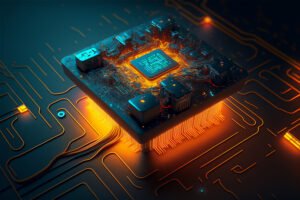High-Performance Computing (HPC) has revolutionized the way we tackle complex computational problems, enabling us to process vast amounts of data and perform intricate simulations at unprecedented speeds.
HPC systems play a pivotal role in various fields, including scientific research, engineering, finance, weather forecasting, and artificial intelligence, among others. To achieve the remarkable performance demanded by these applications, HPC architectures continually evolve, and one such key player in this domain is the Field-Programmable Gate Array (FPGA).
In this blog post, we will delve into the role of FPGAs in high-performance computing. We will explore the architecture and features of FPGAs, highlighting their capabilities and strengths. Additionally, we will examine the ways in which FPGAs contribute to high-performance computing, including acceleration of compute-intensive, memory-intensive, and communication-intensive tasks. Furthermore, we will discuss the design considerations and optimization techniques involved in leveraging FPGAs for HPC.
FPGAs in High-Performance Computing
Field-Programmable Gate Arrays (FPGAs) have emerged as a powerful technology for enhancing the performance and efficiency of high-performance computing (HPC) systems. FPGAs offer unique advantages over traditional computing architectures, making them an attractive choice for accelerating compute-intensive, memory-intensive, and communication-intensive tasks in HPC applications.
A. FPGA-based acceleration for compute-intensive tasks:
Customizable hardware for specific algorithms:
FPGAs allow developers to design and implement custom hardware accelerators tailored to specific computational algorithms. By mapping the algorithms directly onto the FPGA fabric, significant performance gains can be achieved compared to software running on general-purpose processors. This customization capability is particularly valuable for tasks such as numerical simulations, cryptography, and signal processing.
Parallel processing capabilities:
FPGAs excel at parallel processing due to their fine-grained architecture, where computations can be executed simultaneously on multiple logic elements. This parallelism enables high-throughput processing and efficient utilization of computational resources, making FPGAs well-suited for HPC workloads that can be parallelized.
Energy efficiency and power optimization:
FPGAs offer excellent energy efficiency compared to traditional CPUs and GPUs. Their reconfigurable nature allows for dynamic power management, where only the necessary logic elements are activated, reducing power consumption. Additionally, FPGAs can exploit data-level and task-level parallelism, achieving higher performance per watt compared to conventional processors.
B. FPGA-based acceleration for memory-intensive tasks:
Integration of on-chip memory for faster access:
FPGAs typically include dedicated on-chip memory blocks that can be used to create high-bandwidth, low-latency data storage. This integration enables faster access to critical data and reduces the need for frequent transfers between external memory and the processing unit. For memory-intensive applications, such as large-scale simulations or database operations, FPGA-based acceleration can significantly reduce data transfer overhead.
High-bandwidth memory interfaces:
FPGAs can be equipped with high-speed memory interfaces, such as DDR4 or HBM (High-Bandwidth Memory). These interfaces enable efficient data transfer between the FPGA and external memory devices, supporting the high memory bandwidth required by memory-intensive HPC workloads. FPGA-based memory optimization techniques, such as data streaming and caching, further enhance performance by minimizing data movement and improving data locality.
Data streaming and caching techniques:
FPGAs can be programmed to perform data streaming and caching operations efficiently. By streaming data directly from input sources to the FPGA fabric and processing it on-the-fly, latency can be reduced, and overall throughput can be improved. Additionally, FPGA-based caching techniques enable the storage of frequently accessed data closer to the processing unit, minimizing memory access delays and improving overall performance.
C. FPGA-based acceleration for communication-intensive tasks:
Low-latency data transfer and communication protocols:
FPGAs offer low-latency and high-bandwidth communication interfaces, making them suitable for communication-intensive tasks in HPC. They can be utilized to implement high-speed network interfaces, such as 10G Ethernet or InfiniBand, enabling fast and efficient data transfer between HPC nodes. FPGA-based communication solutions are particularly beneficial for applications that heavily rely on inter-node communication, such as distributed computing and data parallelism.
Network interface controllers (NICs) and packet processing:
FPGAs can be leveraged to implement customized Network Interface Controllers (NICs) that offload network-related tasks from the CPU. By performing packet processing, network protocol parsing, and even data compression/decompression directly on the FPGA, the CPU’s burden can be reduced, freeing up its resources for other computations.
Future trends and challenges in FPGA-based high-performance computing
A. Advances in FPGA technology and architecture:
Ongoing advancements in FPGA technology are leading to increased logic capacity, higher performance, and improved power efficiency. Smaller process nodes, higher clock frequencies, and enhanced on-chip resources enable the development of more complex and efficient FPGA-based HPC solutions.
B. Integration of FPGAs with other HPC technologies (e.g., GPUs):
Hybrid architectures that combine FPGAs with other high-performance computing technologies, such as GPUs, offer the potential for even greater performance gains. Combining the parallel processing capabilities of FPGAs with the massive parallelism of GPUs can unlock new levels of performance and efficiency in HPC workloads.
C. Challenges in programming and managing FPGA-based HPC systems:
Programming FPGAs for HPC applications requires specialized skills and tools. High-level synthesis (HLS) tools and domain-specific languages (DSLs) are evolving to simplify FPGA programming, but there is still a learning curve involved. Additionally, managing and optimizing FPGA-based HPC systems, including resource allocation, scheduling, and communication, present challenges that need to be addressed to fully leverage the potential of FPGAs in HPC.
D. Potential impact of FPGA-based HPC on various industries:
The adoption of FPGA-based HPC has the potential to revolutionize various industries, including finance, healthcare, energy, and manufacturing. By enabling faster simulations, data analytics, and decision-making processes, FPGA-based HPC can drive innovation, improve efficiency, and unlock new possibilities in these sectors.
FPGA-based acceleration in high-performance computing
FPGA-based accelerators are increasingly being integrated into HPC clusters to enhance their computational capabilities. These clusters combine the power of traditional CPUs with FPGA accelerators, enabling faster and more efficient execution of HPC workloads. FPGAs can be deployed as co-processors alongside CPUs, offering significant performance boosts for specific computational tasks.
FPGA-based supercomputers and data centers:
The use of FPGAs in supercomputers and data centers is gaining momentum due to their ability to provide both performance and energy efficiency benefits. FPGAs can be integrated into the overall system architecture, augmenting the computational power and enabling specialized acceleration for specific workloads. This integration helps achieve higher throughput, lower power consumption, and reduced operational costs.
Use cases in scientific simulations and modeling:
FPGAs are well-suited for scientific simulations and modeling tasks that involve complex computations. These tasks often require extensive mathematical calculations, such as solving differential equations or performing large-scale simulations. FPGA-based acceleration can significantly reduce execution time, enabling scientists and researchers to obtain results faster and iterate more quickly on their models.
FPGA-accelerated machine learning and artificial intelligence:
The field of machine learning and artificial intelligence (AI) benefits greatly from FPGA-based acceleration. FPGAs can be used to accelerate key operations in machine learning algorithms, such as matrix multiplication, convolution, and activation functions. By offloading these computations to FPGAs, significant speedups can be achieved, leading to faster training and inference times in AI applications.
Conclusion
In conclusion, FPGAs have emerged as a key technology in high-performance computing, offering significant advantages in terms of customizable hardware, parallel processing capabilities, energy efficiency, and memory optimization. FPGA-based acceleration is particularly valuable for compute-intensive, memory-intensive, and communication-intensive tasks in HPC applications.
By leveraging FPGA technology, compute-intensive tasks can benefit from custom hardware accelerators, parallel processing capabilities, and energy-efficient designs. Memory-intensive tasks can take advantage of on-chip memory integration, high-bandwidth memory interfaces, and data streaming/caching techniques. Communication-intensive tasks can benefit from low-latency data transfer, FPGA-based network interfaces, and offloading of network-related tasks from CPUs.


![What is FPGA Introduction to FPGA Basics [2023] computer-chip-dark-background-with-word-intel-it](https://fpgainsights.com/wp-content/uploads/2023/06/computer-chip-dark-background-with-word-intel-it-300x171.jpg)









